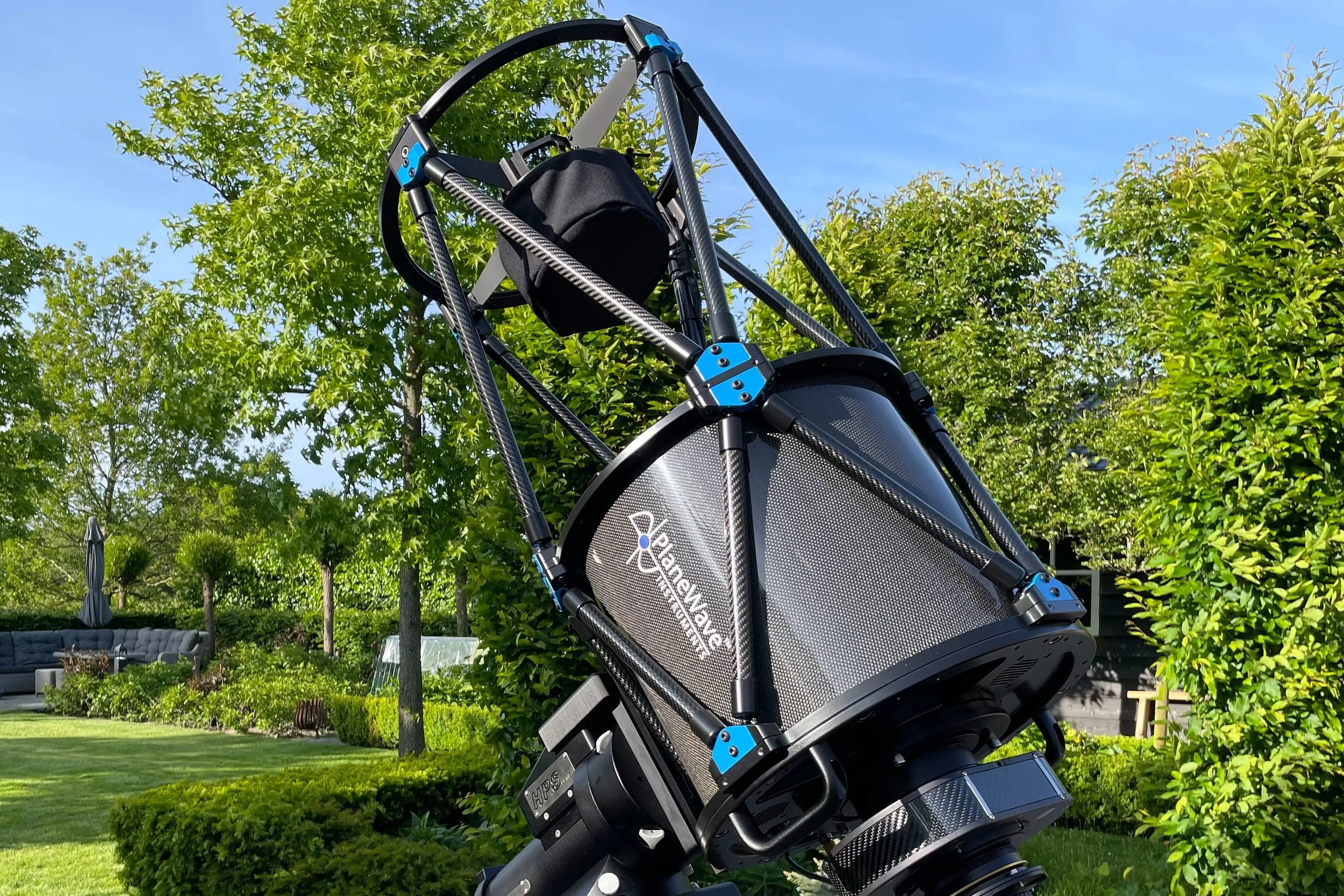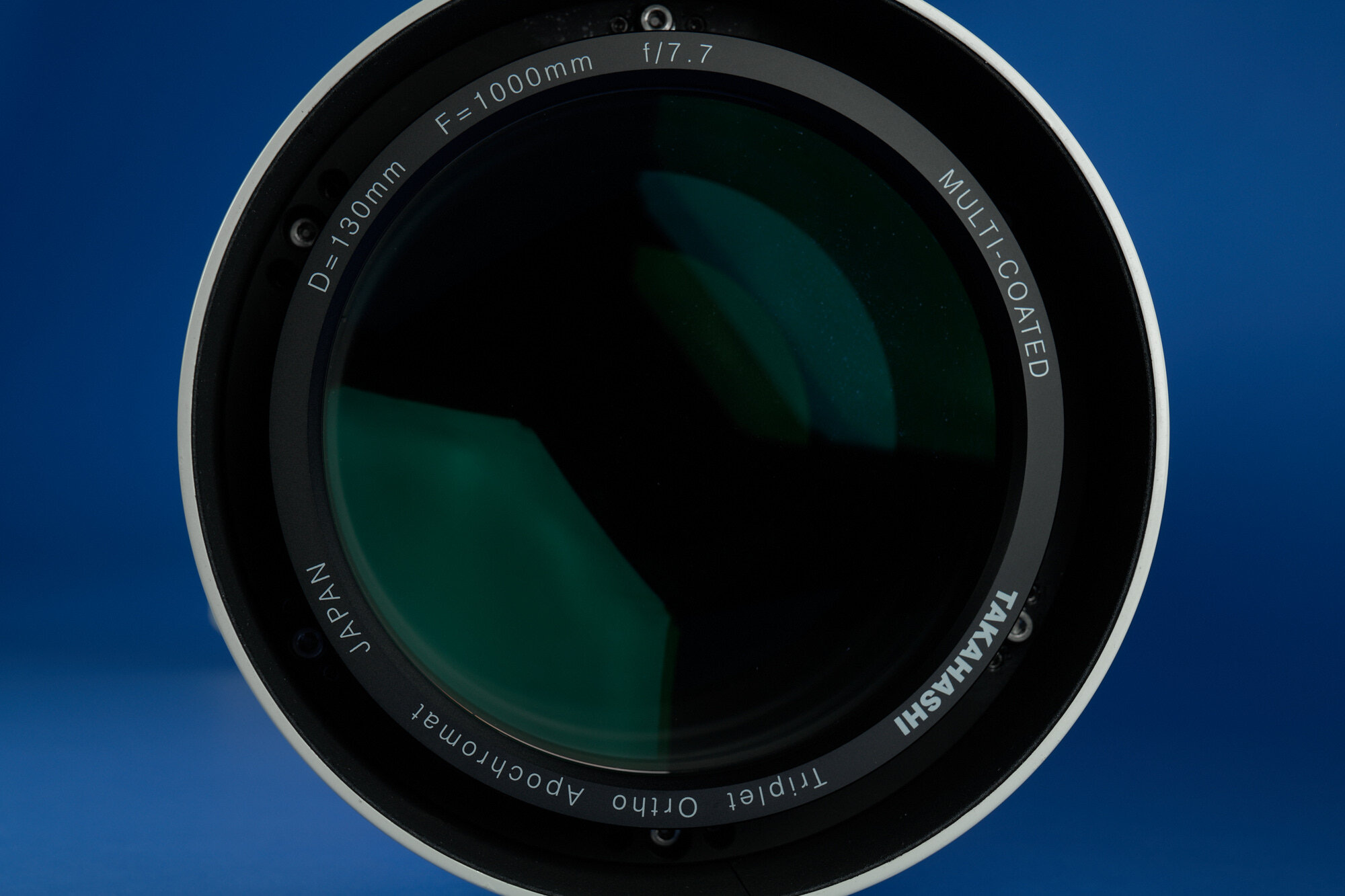PlaneWave CDK14
The main telescope of the observatory is a PlaneWave CDK14. This is a 14 inch reflector telescope of the Dall-Kirkham design. One of the main benefits of this telescope is the fact that the corrective lenses between secondary mirror and camera are laser-aligned mounted in the primary mirror housing. This means that the only collimation is via the secondary mirror. In the Dall-Kirkham design, the secondary mirror is spherical, so collimation is a lot easier than similar telescopes of a Ritchy-Crétien design. Originally the telescope was meant to run from a mobile setup in the backyard, but in early 2024 the telescope was moved to a remote observatory in Spain in a permanent setup.
Specifications
Aperture: 356mm
Focal length: 2563mm
Focal Ratio: f/7.2
Image circle: 70 mm
Length: 889 mm
Weight: 22 kg
Truss Design
The CDK14 is built in a so-called truss design, typically used for larger telescopes. It is a very strong triangulated system of carbon-fibre rods. It provides a large amount of rigidity, while keeping the weight down compared to regular tube-based systems.
Collimation
To collimate the CDK series of telescopes, only the three set-screws of the secondary mirror need to be used. The collimation screws are easily accessible at the front of the telescope. No adjustments to the primary mirror need to be made.
Primary mirror
The primary mirror is a 14” elliptical mirror, which is remarkably light for its size. The total weight of the CDK14 is very comparable to the 12.5” version. A precisely designed large 3D-printed baffle ensures that no stray-light will be entering the light path.
Backplate
The imaging train is connected to the backplate of the telescope via a large plate that sits flush against the scope and held in place with a large ring, bolted with six screws. The fans force air to blow past the primary mirror to shorten cool-down times.
Humidity control
The scope comes equipped with heaters and temperature sensors for both mirrors, but no humidity sensor. The electronics is a real mess and sub-par compared to the quality of the telescope. Using a separate box (Delta-T), mirror heaters can be controlled.
The Full Rig
Back-focus distance at native focal length is large and allows for a lot of flexibility in designing the optimal imaging trail, with room on the backplate to mount control boxes. To reduce stray light coming into the scope, a shroud can be stretched over the truss.
Takahashi TOA-130 NFB
The first telescope of the observatory was the Takahashi TOA-130 in 2017. After comparing all options and reading endless discussions on the various forums on reflectors vs refractors, a refractor was chosen. The choice for a Takahashi telescope was made based on build quality and optical quality. The 1000mm focal length works well as an all-rounder, good for both nebulae and galaxies. With rings, focuser and camera, the weight is probably a little over 15kg. While not light, it works very well for a mobile setup.
Specifications
Aperture: 130mm
Focal length: 1000mm
Focal Ratio: f/7.7
Image circle: 90mm (67-FL)
Length: 1022/1155mm
Weight: 12.3kg
Focuser
The TOA-130 NFB comes with its own robust 4” focuser and camera-rotator. Unfortunately the rotator has no rotation angle indicator on it. So I made a 360 degree label with indicators. This makes it very easy to rotate to the same angle between targets and/or sessions.
67-FL Flattener
The 40 mm image circle of the standard TOA-35 flattener covers APS-C sized sensors or smaller. To accommodate bigger sensors, a 67-FL flattener is applied. It comes with its own TOA-130-specific Takahashi 82 spacer. The image circle is 90mm, more than enough for even a medium format camera.
Rings
For mounting, Primalucelab tube-rings are used. Availability and the stylish red-color were part of the decision. An extra reversed losmandy-style dovetail plate is placed on top. It has velcro stuck on it to attach the acquisition computer, power distributor, etc.
Auto-Focuser
Autofocusing is done with the Sesto Senso from Primalucelab. Motor and controller are one device. Installing the Sesto Senso on the telescope is a bit tricky, as it must be very precisely aligned. But once in place it works well, with very little, if any, backlash. This is version 1. An updated version 2, with WiFi on-board, has been released.
Hardcase
Transportability is an important aspect for a mobile setup. Proper protection for such a sensitive instrument is critical. The Pelican 1740 appeared to be the right size and serves as a snug fit for the telescope with rings, auto-focuser, flattener and adapters attached.
Takahashi FSQ-106 EDX4
As the astrophotography hobby developed, so did the desire for more versatility. The interest grew towards a wider field of view. There are two ways to achieve this: either a larger sensor, or a shorter telescope. The decision was made for the latter. And when in early 2019 the TOA-130 had to be sent in for maintenance, an FSQ-106 was welcomed to the observatory. This telescope is designed for astrophotography. It is a quadruplet APO-refractor of the Petzval design. The imaging circle is 88mm, straight out of the box. The weight of the telescope is only 7kg, so with rings and camera probably just over 10kg. A modest scope in physical dimensions, but fast at f/5.0 and with stunning image quality.
Specifications
Aperture: 106mm
Focal length: 530mm
Focal Ratio: f/5.0
Image circle: 88mm
Length: 580/675mm
Weight: 7.0kg
Focuser
The FSQ-106 EX4 comes with a similar robust 4” focuser and camera rotator as the TOA-130. A rotation angle indicator, like on the TOA-130 still needs to be made. Between targets and/or sessions this makes it very easy to rotate to the same angle again.
Balancing weight
Because of the small size of the telescope, the heavy imaging train, and short dovetail, balancing the scope on the mount is nearly impossible without sliding the dovetail too far out of the mount. Therefore a balancing counterweight of 1.5kg is attached to the front end of the dovetail.
EOS-EF mount
Camera is connected through he same Takahashi 33 wide T-mount EOS adapter (TKA01251), but now screwed directly onto the telescope. There is no special flattener in the design, so no particular fixed back-focus distance to be met.
Rings
For mounting, Primaluce tube-rings are used. The rings are attached to a 24cm Losmandy-style dovetail plate. With the rings attached, the hood can not be completely retracted. An extra 2cm spacer is used to give some room for the hood. A 14cm reversed Losmandy-style dovetail plate is placed on top. Velcro allows the acquisition computer, power distributor, etc. to be attached.
Auto-Focuser
For autofocusing, the same Sesto Sensor (version 1) from Primalucelab is used. Primalucelab has release an updated version 2, with WiFi on-board. Focusing is an important part of imaging, and having the same focuser on both scopes helps a lot in practical use.
Hardcase
The hardcases that came with the mount were from HPRC. Having used both HPRC and Pelican cases, I very much prefer the HPRC’s. Finding a proper one for the FSQ-106 was not easy. The final choice was for the HPRC6200, a cylindrical case. The telescope with everything attached just fits.















